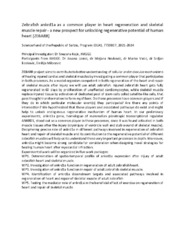Приказ основних података о документу
Zebrafish ankrd1a as a common player in heart regeneration and skeletal muscle repair - a new prospect for unlocking regenerative potential of human heart (ZEBARR)
| dc.date.accessioned | 2023-12-12T18:30:09Z | |
| dc.date.available | 2023-12-12T18:30:09Z | |
| dc.date.issued | 2021 | |
| dc.identifier.uri | https://imagine.imgge.bg.ac.rs/handle/123456789/2272 | |
| dc.description.abstract | ZEBARR project aims to contribute to better understanding of cellular and molecular mechanisms of healing injured cardiac and skeletal muscles by investigating a common player that participates in both processes. As a model organism competent in both regeneration of the heart and repair of skeletal muscle after injury we will use adult zebrafish. Injured zebrafish heart gets fully regenerated in 60 days by proliferation of unaffected cardiomyocytes, while skeletal muscle replace injured tissue by activation of dedicated pool of stem cells called satellite-like cells, that pass thought transformation to form myofibers. Do these processes have common players and if they do in which particular molecular event(s) they participate? Are there any points of intersection? We hypothesized that these players and associated pathways do exist and might help to unlock endogenous regenerative mechanism of human heart. In our preliminary experiments, ankrd1a gene, homologue of mammalian pleiotropic transcriptional regulator ANKRD1, stood out as a common player in these processes, since it was found activated in both muscle tissues after the injury (cryoinjury of ventricle wall and stab wound of skeletal muscle). Deciphering precise role of ankrd1a in different pathways involved in regeneration of zebrafish heart and repair of skeletal muscle and its contribution to the regenerative potential of different zebrafish muscles will help us to understand these very important processes in depth. Moreover, ankrd1a might become strong candidate for consideration when designing novel strategies for healing human heart after myocardial infraction. Experimental work will be organized in five work packages: WP1. Determination of spatio-temporal profile of ankrd1a expression after injury of adult zebrafish heart and skeletal muscle. WP2. Investigation of ankrd1a function in regeneration of adult zebrafish heart. WP3. Investigation of ankrd1a function in repair of adult zebrafish skeletal muscle. WP4. Identification of ankrd1a downstream targets and associated pathways involved in regeneration of heart and repair of skeletal muscle of adult zebrafish WP5. Testing the mediator role of ankrd1a in the beneficial effect of exercise on regeneration of heart and repair of skeletal muscle. | sr |
| dc.language.iso | en | sr |
| dc.relation | info:eu-repo/grantAgreement/ScienceFundRS/Ideje/7739807/RS// | sr |
| dc.rights | openAccess | sr |
| dc.rights.uri | https://creativecommons.org/licenses/by/4.0/ | |
| dc.source | Science Fund of the Republic of Serbia, Program IDEAS | sr |
| dc.title | Zebrafish ankrd1a as a common player in heart regeneration and skeletal muscle repair - a new prospect for unlocking regenerative potential of human heart (ZEBARR) | sr |
| dc.type | other | sr |
| dc.rights.license | BY | sr |
| dc.description.other | Principal Investigator: Dr Snezana Kojic, IMGGE | sr |
| dc.description.other | Duration period: 2021-2024 | |
| dc.identifier.fulltext | https://imagine.imgge.bg.ac.rs/bitstream/id/524969/ZEBARR.pdf | |
| dc.identifier.rcub | https://hdl.handle.net/21.15107/rcub_imagine_2272 | |
| dc.type.version | publishedVersion | sr |

